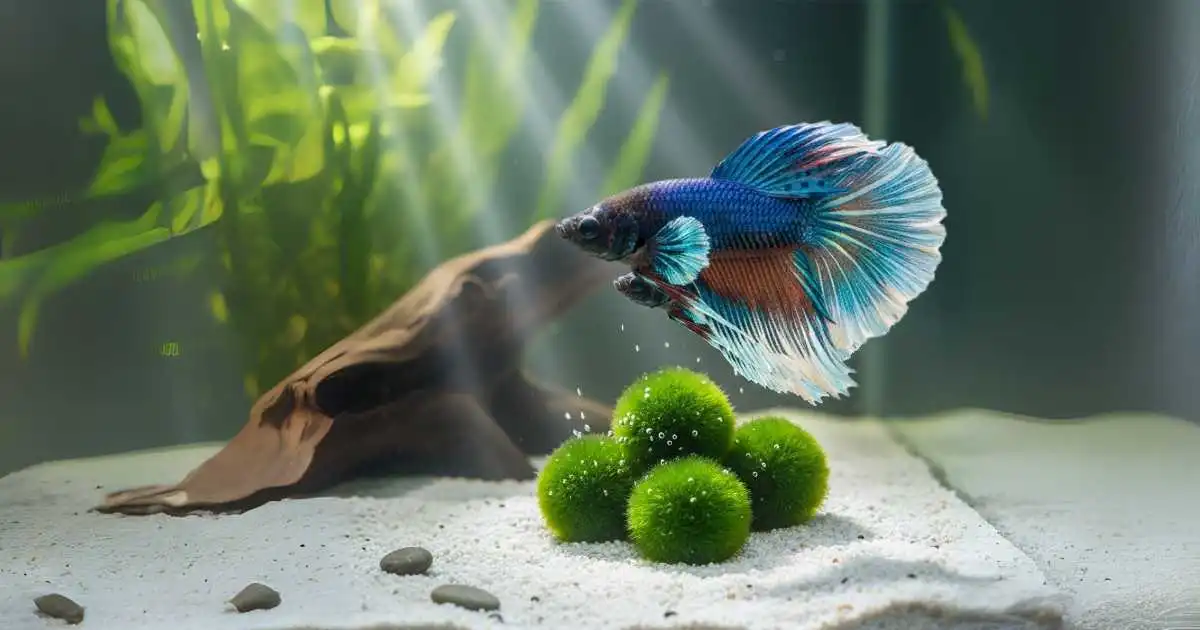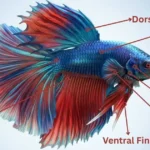My betta Cosmo had a strange habit. Every afternoon around 3 PM, he’d swim down to his marimo moss ball and just plop himself on top of it like a tiny green couch. Sometimes he’d push it around the tank for a few minutes first, like he was rearranging furniture. When I added a second marimo moss ball betta companion to his tank, he claimed both as his personal rest stops. Watching him interact with these fuzzy green orbs convinced me they’re one of the best additions you can make to a betta tank.
Marimo moss balls are more than just decorative aquarium plants. They provide real benefits for betta fish while requiring almost zero maintenance. If you’ve ever killed every plant you’ve tried to keep, marimo might be your redemption. Let me share everything you need to know about keeping these unique algae balls with your betta.
Quick Summary
| Aspect | Details |
| What They Are | Spherical algae (Aegagropila linnaei), not actual moss |
| Betta Compatibility | Excellent – bettas love playing with and resting on them |
| Main Benefits | Absorbs nitrates, produces oxygen, provides enrichment |
| Care Difficulty | Extremely easy – nearly indestructible |
| Growth Rate | Very slow – only 5mm per year |
| Temperature Range | 65-80°F (bettas prefer 76-80°F) |
| Lifespan | 100+ years with proper care |
| Cost | $5-15 depending on size |
Real vs Fake Marimo:
- Real: Living algae, provides filtration benefits, soft texture
- Fake: Synthetic material around foam core, no water quality benefits, harder texture
What Are Marimo Moss Balls?
Despite their name, marimo moss balls aren’t moss at all. They’re a rare form of spherical algae scientifically known as Aegagropila linnaei. The name “marimo” comes from Japanese, roughly translating to “bouncy water plant ball.” Pretty accurate description if you ask me.
Natural Habitat and Formation
Marimo naturally form in cold freshwater lakes in Japan, Iceland, Scotland, and Estonia. In these lakes, the algae grows in shallow water where wave action and currents tumble it along the lake bottom. This constant rolling motion shapes loose algae filaments into perfect spheres over many years.
Wild marimo can grow to 8-12 inches in diameter, though this takes decades. The largest specimens are considered national treasures in Japan and protected by law. Most marimo moss ball aquarium varieties sold commercially range from 1-3 inches.
In Japanese culture, marimo symbolize close family bonds and good luck. Families pass them down through generations as living heirlooms. Since marimo can live 200+ years, your great-grandchildren could inherit the same moss ball you buy today. That’s pretty incredible for an aquarium plant.
Benefits of Marimo Moss Balls for Betta Fish
The marimo moss ball benefits for betta go beyond aesthetics. These green spheres actively improve your tank environment.
Water Quality Benefits
Nitrate Reduction:
- Absorbs nitrates through photosynthesis
- Helps keep nitrate levels below 20 ppm
- Reduces frequency of water changes (though never eliminates them)
- Acts as a supplemental biofilter
Oxygenation:
- Produces oxygen during photosynthesis
- Supplements dissolved oxygen in water
- Beneficial for bettas despite their labyrinth organ
- Helps maintain healthy aerobic bacteria
Ammonia Processing:
- Absorbs small amounts of ammonia from water
- Cannot replace nitrogen cycle or filtration
- Provides minor water quality support
- Works alongside beneficial bacteria
Enrichment and Entertainment
Are marimo moss balls good for bettas behaviorally? Absolutely. Here’s what I’ve observed:
Physical Interaction:
- Bettas push moss balls around like toys
- Use them as resting platforms near the surface
- Nestle against them when sleeping
- Chase them when water current moves them
My betta Luna spent at least 30 minutes daily interacting with her moss ball. She’d push it from one corner to another, rest on top for a while, then push it somewhere else. This natural behavior keeps bettas mentally stimulated and physically active.
Stress Reduction:
- Provides hiding spots when placed near decorations
- Creates visual barriers in the tank
- Gives bettas territory markers
- Adds natural element to environment
Aesthetic Appeal
Let’s be honest – marimo look cool. Their bright green color contrasts beautifully with colorful bettas. They add organic curves to angular tank designs. You can arrange them individually or cluster them for different visual effects.
The velvety texture catches light in interesting ways. When bubbles from photosynthesis cling to their surface, they shimmer like tiny green disco balls. Some hobbyists create entire aquascapes around large marimo specimens.
[Internal link opportunity: Link to “Betta Tank Setup Ideas” here]
Do Betta Fish Like Moss Balls?

In my experience keeping bettas with marimo, about 80% show clear interest. The other 20% ignore them completely, which is fine too. Every betta has unique personality traits.
My betta Sage treated his marimo like a beloved pet rock. He’d sleep on it, push it into his favorite corner, and flare at me if I moved it during cleaning. When I propagated his marimo into two smaller balls, he seemed genuinely excited to have more furniture options.
Contrast that with my betta Blaze, who couldn’t care less about his moss ball. It sat in his tank for months without him acknowledging its existence. Both bettas were healthy and happy – they just had different interests.
Signs your betta likes their moss ball:
- Regularly resting on or near it
- Pushing it around the tank
- Investigating it during active periods
- Choosing to sleep against it
Your betta probably doesn’t care if:
- Never interacts with it
- Swims around it without acknowledgment
- Shows no preference for the area where it sits
Either response is normal. The water quality benefits exist regardless of whether your betta plays with their moss ball.
Marimo Moss Ball Care Guide
This is the easiest care section I’ll ever write. Marimo are nearly indestructible.
Light Requirements
Marimo need light for photosynthesis but tolerate a wide range:
Ideal lighting:
- Low to medium aquarium light
- Standard LED tank light works perfectly
- Household room lighting sufficient
- 6-8 hours daily
Avoid:
- Direct sunlight (causes brown spots)
- High-intensity LED directly above
- Complete darkness for extended periods
I keep my marimo under standard aquarium LEDs for 8 hours daily. They maintain vibrant green color and slowly produce oxygen bubbles. No special lighting needed.
Temperature Needs
Wild marimo grow in cold water (40-65°F). Fortunately, they adapt well to warmer temperatures suitable for bettas.
Temperature tolerance:
- Survive: 65-85°F
- Prefer: 65-75°F
- Betta temperature (76-80°F): Works fine
- Above 82°F: May develop brown spots
My bettas live at 78-80°F year-round. Their marimo thrive at these temperatures despite preferring cooler water. The key is stability – avoid temperature fluctuations.
Water Requirements
pH: Tolerates 6.0-8.5 (betta-safe range of 6.5-7.5 perfect)
Hardness: Adaptable to soft or hard water
Water type: Tap water (dechlorinated), RO water, or aquarium water all work
Salinity: Can even survive in slightly brackish water
This adaptability makes marimo moss ball care incredibly forgiving. If your water parameters are safe for bettas, they’re safe for marimo.
Rotation and Maintenance
Weekly rotation:
- Gently pick up moss ball during water changes
- Rotate 90-180 degrees
- Place back in tank in different orientation
Why rotation matters: Marimo need light exposure on all sides. Without rotation, the bottom becomes shaded and may turn gray or brown. Rotating ensures even light distribution and maintains spherical shape.
Monthly deep clean:
- Remove moss ball from tank
- Rinse under dechlorinated water
- Gently squeeze 2-3 times to release trapped debris
- Roll between your palms for 10-15 seconds
- Return to tank
I rotate my marimo every Saturday during water changes. Takes 5 seconds per ball. The monthly squeeze removes accumulated debris and maintains their round shape.
Common Marimo Moss Ball Problems
Marimo Moss Ball Turning Brown
Brown spots or overall browning indicate stress. Common causes and solutions:
Too much light:
- Symptoms: Brown patches on top or sunny side
- Solution: Move away from window or reduce lighting duration
- Prevention: Keep out of direct sunlight
Temperature too high:
- Symptoms: Overall brownish color, sluggish appearance
- Solution: Lower tank temperature or give “vacation” in refrigerator for 1-2 days
- Prevention: Maintain temperature below 82°F
Poor water quality:
- Symptoms: Grayish-brown discoloration, slimy texture
- Solution: Perform water change, improve maintenance schedule
- Prevention: Regular water testing and changes
I had a marimo turn brown when my room temperature hit 88°F during a heatwave. I placed it in a container of dechlorinated water in my refrigerator for 24 hours. It recovered to bright green within a week.
Floating Issues
New marimo often float for 1-2 days. This is normal – air bubbles are trapped inside.
How to fix floating marimo:
- Hold moss ball underwater
- Gently squeeze to release air bubbles
- Roll between palms briefly
- Place on tank bottom
If your marimo repeatedly floats after days in the tank, it’s producing lots of oxygen through photosynthesis. This is actually a good sign of health. Just squeeze it occasionally to release excess oxygen.
Losing Shape
Marimo can become misshapen if left stationary too long.
Reshaping process:
- Remove from tank during water change
- Squeeze out excess water
- Roll vigorously between palms for 30-60 seconds
- Continue rolling until roughly spherical
- Return to tank
For severely flattened marimo, wrap with cotton thread temporarily. The thread maintains pressure that encourages spherical growth. Remove thread after 2-3 weeks.
How to Propagate Marimo Moss Balls
Marimo moss ball propagation lets you create multiple balls from one large specimen.
Step-by-step propagation:
- Remove moss ball from tank and squeeze out all water
- Cut in half using clean scissors or knife
- Tear each half into desired portions (halves, thirds, or quarters)
- Roll each portion between your palms for 2-3 minutes
- Wrap with thread (optional) to maintain shape initially
- Place in dechlorinated water and let rehydrate
- Add to tank after 2-4 hours
I propagated a 3-inch marimo into four 1-inch babies. They looked rough initially but rounded out after 2-3 weeks of regular rotation. Now they’re perfectly spherical and growing slowly.
New marimo grow approximately 5mm per year. That 1-inch baby ball will take 2-3 years to reach 2 inches. Marimo moss ball growth rate is glacially slow, but that’s part of their charm.
Real vs Fake Marimo Moss Balls
Unfortunately, not all “moss balls” sold are real marimo. Here’s how to identify authentic ones.
Real Marimo characteristics:
- Soft, velvety texture throughout
- Uniform green color (no color variations)
- Dense algae with no hard center
- Slightly squishy when squeezed
- Will eventually produce tiny oxygen bubbles
- Sold in water or very damp packaging
Fake moss ball indicators:
- Rough or plastic-feeling exterior
- Hard foam or plastic core inside
- Color variations or unnatural bright green
- Sold completely dry in packaging
- Very lightweight even when dry
Where to buy marimo moss balls safely:
- Reputable online aquarium plant sellers
- Local fish stores with good reputations
- Established aquarium plant farms
- Hobbyist forums and groups (after quarantine)
Avoid:
- Generic big-box stores (often fake)
- Unmarked packaging without care info
- Suspiciously cheap prices (under $3 per ball)
- Sellers who can’t confirm species
I learned this lesson the hard way. I bought three “moss balls” from a discount store for $2 each. They looked okay initially but never produced oxygen bubbles and felt wrong. After cutting one open, I found a foam core wrapped in synthetic fibers. Complete fakes.
[Internal link opportunity: Link to “Best Live Plants for Bettas” here]
Zebra Mussel Warning (Critical)
⚠️ IMPORTANT: In 2021, invasive zebra mussels were discovered in commercial moss ball shipments across the United States. These invasive mollusks cause massive ecological damage to native waterways.
Before adding any moss ball to your tank:
- Inspect thoroughly for small striped shells (2-3mm)
- Quarantine in separate container for 1-2 weeks
- Dispose properly if mussels found – freeze for 48 hours, then trash (never drain)
- Report to state environmental agency if found
This issue mostly affected 2021 shipments, but remain vigilant. Never release aquarium water or plants into natural waterways. Always inspect carefully before adding to your betta tank.
Setting Up Marimo in Betta Tank
First-time setup:
- Rinse thoroughly under dechlorinated water for 30 seconds
- Squeeze gently to remove any trapped debris
- Inspect carefully for any hitchhikers or abnormalities
- Place in tank where you want it to sit
- Allow to sink (may take 1-2 days if new)
Ideal placement:
- Tank bottom: Natural resting place, easy for betta to access
- Mid-level: Wedged between decorations for visual interest
- Against glass: Creates interesting viewing angle
- Near resting spots: Bettas appreciate moss balls near their favorite lounging areas
How many marimo for betta tank:
- 2.5-5 gallon tank: 1-2 small moss balls
- 5-10 gallon tank: 2-4 small-medium balls
- 10+ gallon tank: 3-6 balls of various sizes
I keep two 2-inch marimo in my 10-gallon betta tanks. This provides benefits without overcrowding. More isn’t always better – leave swimming space for your betta.
FAQs
- Are marimo moss balls good for bettas?
Yes, marimo moss balls are excellent for bettas. They provide water quality benefits by absorbing nitrates and producing oxygen. Bettas enjoy resting on them and pushing them around for enrichment. They’re completely safe and many bettas develop strong preferences for their moss balls as resting spots or toys.
- How often do I need to clean marimo moss balls?
Clean marimo moss balls once monthly by removing, rinsing in dechlorinated water, and gently squeezing out debris. Rotate them weekly during regular water changes to ensure all sides receive light. This minimal maintenance keeps them healthy and maintains their spherical shape.
- Can marimo moss balls replace my filter?
No, marimo cannot replace filtration. While they absorb some nitrates and produce oxygen, they don’t provide the mechanical and biological filtration that proper filters supply. Think of marimo as supplemental water quality support, not a replacement for essential equipment. Always maintain appropriate filtration for your betta.
- Why is my marimo moss ball floating?
Floating marimo usually contain trapped air bubbles. This is normal for new moss balls or those producing lots of oxygen through photosynthesis. Gently squeeze the ball underwater to release air bubbles. If it repeatedly floats, this indicates healthy photosynthesis. Just squeeze occasionally to keep it on the tank bottom.
- Do betta fish like moss balls or will they ignore them?
Most bettas (about 80% in my experience) show interest in moss balls by resting on them, pushing them around, or sleeping against them. About 20% of bettas ignore them completely. Both responses are normal. Even if your betta ignores their moss ball, the water quality benefits still apply.
Conclusion
Marimo moss balls rank among the best additions you can make to a betta tank. They’re virtually indestructible, require almost zero maintenance, and provide genuine water quality benefits. Most bettas enjoy interacting with them, turning these green spheres into both toys and furniture.
After keeping marimo in betta tanks for years, I’ve never had one die or cause problems. They quietly improve water quality while giving bettas something interesting to interact with. The slow growth rate means they won’t overtake your tank. The minimal care requirements mean you can’t really mess them up.
Start with one or two small marimo and observe how your betta responds. You might discover your betta has the same afternoon lounging ritual my Cosmo did. Or you might have a betta like Blaze who prefers ignoring their moss ball entirely. Either way, your tank benefits from their presence. These fuzzy green companions are as close to “set it and forget it” as aquarium keeping gets.
About the Author
Hey, I'm Bryan (founder of bettafishwave.com/). I've kept marimo moss balls in betta tanks for over 6 years across more than a dozen setups. I've propagated marimo successfully, recovered brown specimens, and observed how different bettas interact with them. My fascination with these unique algae balls led me to research their biology, natural habitat, and optimal care methods. I've tested various placement strategies, lighting conditions, and maintenance schedules to determine what works best for betta compatibility. My goal is to help betta keepers understand why marimo make such excellent tank companions and how to keep them thriving. For more betta care guides, plant recommendations, and tank setup advice, visit bettafishwave.com/.
References:
- Boedeker, C., et al. (2010). “Aegagropila linnaei: Molecular Phylogeny and Growth Patterns.” Journal of Phycology, Vol. 46, Issue 2.
- Yoshida, T. (1994). “Japanese Freshwater Algae: Aegagropila Species and Cultural Significance.” Tokyo Marine Science University Press.
- Aquatic Plant Management Society. (2022). “Invasive Species Alert: Zebra Mussels in Aquarium Trade.”
- Stevens, K. (2019). “Aquarium Plant Filtration: Nutrient Uptake by Common Species.” Aquatic Sciences Journal, Vol. 81, pp. 445-458.



